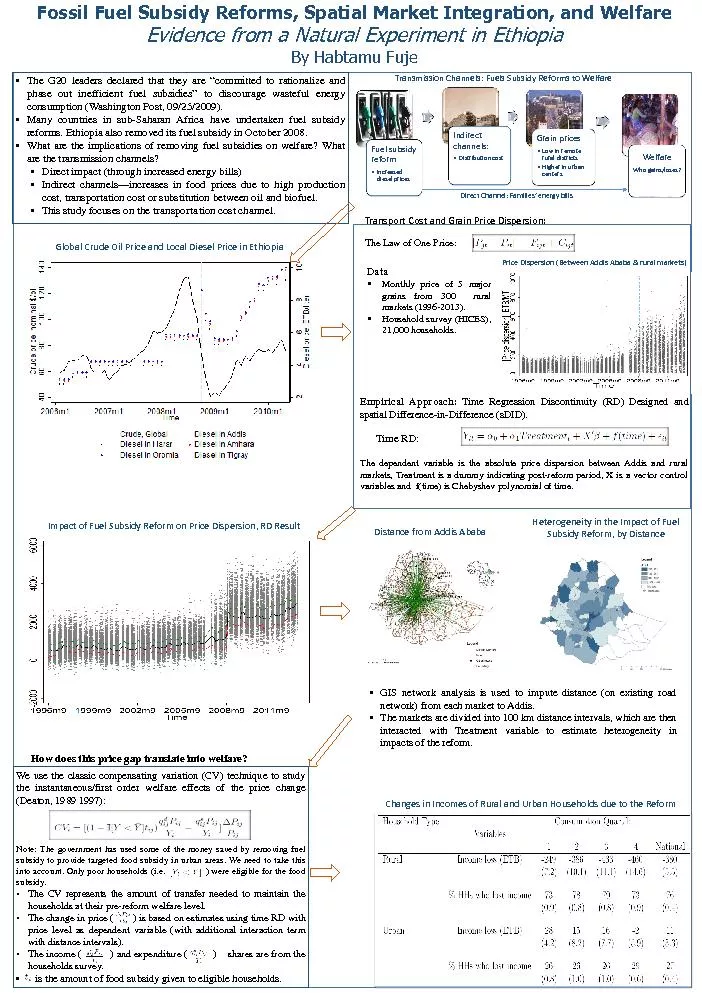

Evidence from a Natural Experiment in Ethiopia By Habtamu Fuje Fuel subsidy reform Increased diesel prices Indirect channels Distribution cost Grain prices Low in remote rural distric ID: 843835
Download Pdf The PPT/PDF document "Fossil Fuel Subsidy Reforms Spatial Mark..." is the property of its rightful owner. Permission is granted to download and print the materials on this web site for personal, non-commercial use only, and to display it on your personal computer provided you do not modify the materials and that you retain all copyright notices contained in the materials. By downloading content from our website, you accept the terms of this agreement.
1 Fossil Fuel Subsidy Reforms, Spatial Mar
Fossil Fuel Subsidy Reforms, Spatial Market Integration, and Welfare Evidence from a Natural Experiment in Ethiopia By Habtamu Fuje Fuel subsidy reform • Increased diesel prices Indirect channels: • Distribution cost Grain prices • Low in remote rural districts • Higher in urban centers Welfare Who gains/loses? Direct Channel: Families’ energy bills Global Crude Oil Price and Local Diesel Price in Ethiopia Transmission Channels: Fuels Subsidy Reforms to Welfare Transport Cost and Grain Price Dispersion: The Law of One Price: The G 20 leaders declared that they are “committed to rationalize and phase out inefficient fuel subsidies” to discourage wasteful energy consumption (Washington Post, 09 / 25 / 2009 ) . Many countries in sub - Saharan Africa have undertaken fuel subsidy reforms . Ethiopia also removed its fuel subsidy in October 2008 . are the implications of removing fuel subsidies on welfare? What are the transmission channels? Direct impact (through increased energy bills) Indirect channels — increases in food prices due to high production cost, transportation cost or substitution between oil and biofuel . This study focuses on the transportation cost channel . Time RD: Data price of 5 major grains from 300 rural markets ( 1996 - 2013 ) . Household survey (HICES), 21 , 000 households . Price Dispersion (Between Addis Ababa & rural markets) Empirical Approach : Time Regression Discontinuity (RD) Designed and spatial Difference - in - Difference ( sDID ) . The dependent variable is the absolute price dispersion between Addis and rural markets, Treatment is a dummy indicating post - reform period, X is a vector control variables and f(time) is Chebyshev polynomial of time . Impact of Fuel Subsidy Reform on Price Dispersion, RD Result Heterogeneity in the Impact of Fuel Subsidy Reform, by Distance Distance from Addis Ababa We use the classic compensating variation (CV) technique to study the instantaneous/first order welfare effects of the price change (Deaton, 1989 ) : Note : The government has used some of the money saved by removing fuel subsidy to provide targeted food subsidy in urban areas . We need to take this into account . Only poor households (i . e . ) were eligible for the food subsidy . • The CV represents the amount of transfer needed to the households at their pre - reform welfare level . • The change in price ( ) is based on estimates using time RD with price level as dependent variable (with additional interaction term with distance intervals) . • The income ( ) and expenditure ( ) shares are from the households survey . • is the amount of food subsidy given to eligible households . GIS network analysis is used to impute distance (on existing road network) from each market to Addis . The markets are divided into 100 km distance intervals, which are then interacted with Treatment variable to estimate heterogeneity in impacts of the reform . Changes in Incomes of Rural and Urban Households due to the Reform How does this price gap translate into welfare?